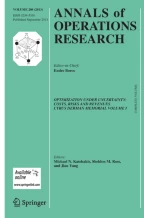Abstract
In this tutorial paper, we consider the basic image reconstruction problem which stems from discrete tomography. We derive a graph theoretical model and we explore some variations and extensions of this model. This allows us to establish connections with scheduling and timetabling applications. The complexity status of these problems is studied and we exhibit some polynomially solvable cases. We show how various classical techniques of operations research like matching, 2-SAT, network flows are applied to derive some of these results.
Similar content being viewed by others
References
Ahuja, R. K., Magnanti, T. L., & Orlin, J. B. (1993). Network flows. Englewood Cliffs: Prentice-Hall.
Alfandari, L., Lemalade, J. L., Nagih, A., Plateau, G. (2009, in press). A MIP flow model for crop-rotation planning in a sustainable development context. Annals of Operations Research.
Alpers, A., Rodek, L., Poulsen, H. F., Knudsen, E., & Herman, G. T. (2007). Discrete tomography for generating maps of polycrystals. In G. T. Herman & A. Kuba (Eds.), Advances in discrete tomography and its applications (pp. 271–301). Boston: Birkhäuser.
Aspvall, B., Plass, M. F., & Tarjan, R. (1979). A linear-time algorithm for testing the truth of certain quantified Boolean formulas. Information Processing Letters, 8, 121–123.
Batenburg, K. J. (2007). Network flow algorithms for discrete tomography. In G. T. Herman & A. Kuba (Eds.), Advances in discrete tomography and its applications (pp. 175–207). Boston: Birkhäuser.
Baumann, J., Kiss, Z., Krimmel, S., Kuba, A., Nagy, A., Rodek, L., Schillinger, B., & Stephan, J. (2007). Discrete tomography methods for nondestructive testing. In G. T. Herman & A. Kuba (Eds.), Advances in discrete tomography and its applications (pp. 303–332). Boston: Birkhäuser.
Bentz, C., Costa, M.-C., de Werra, D., Picouleau, C., & Ries, B. (2008). On a graph coloring problem arising from discrete tomography. Networks, 51(4), 256–267.
Bentz, C., Costa, M.-C., de Werra, D., Picouleau, C., & Ries, B. (2009). Degree-constrained edge partitioning in graphs arising from discrete tomography. Journal of Graph Algorithms and Applications, 13(2), 99–118.
Berge, C. (1983). Graphes. Paris: Gauthier-Villars.
Brocchi, S., Frosini, A., & Picouleau, C. (2008). Reconstruction of binary matrices under fixed size neighborhood constraints. Theoretical Computer Science, 406, 43–54.
Chrobak, M., & Dürr, C. (2001). Reconstructing polyatomic structures from X-rays: NP-completeness proof for three atoms. Theoretical Computer Science, 259(1), 81–98.
Costa, M.-C., de Werra, D., & Picouleau, C. (2006). Using graphs for some discrete tomography problems. Discrete Applied Mathematics, 154, 35–46.
Costa, M.-C., de Werra, D., Picouleau, C., & Schindl, D. (2005). A solvable case of image reconstruction in discrete tomography. Discrete Applied Mathematics, 148, 240–245.
de Werra, D., Costa, M.-C., Picouleau, C., & Ries, B. (2008). On the use of graphs in discrete tomography. 4OR, 6, 101–123.
Déroche, G. (1986). Guy Dupuy: sculpteur discret. Horizons d’Argonne, 52, 104–105.
Déroche, G. (2003). Tomographie agricole des vallées de l’Aisne et de l’Aire. Horizons d’Argonne, 80, 17–20.
Di Gesù, V., & Kuba, A. (Eds.) (2005). Special issue: IWCIA 2003, ninth international workshop on combinatorial image analysis. Discrete Applied Mathematics 151(3), 1–246.
Dürr, C., Guiñez, F., & Matamala, M. (2009). Reconstructing 3-colored grids from horizontal and vertical projections is NP-hard. Technical report. arXiv:0904.3169.
Even, S., Itai, A., & Shamir, A. (1976). On the complexity of timetable and multicommodity flow problems. SIAM Journal on Computing, 5, 691–703.
Gabow, H., Nishizeki, T., Kariv, O., Leven, D., & Tereda, O. (1985). Algorithms for edge-coloring. Technical report 41/85, Tel Aviv University.
Gardner, R. J. (2006). Geometric tomography (2nd ed.). New York: Cambridge University Press.
Garey, M., & Johnson, D. S. (1979). Computer and intractability. San Francisco: Freeman.
Hansen, P., & de Werra, D. (1997). Nesticity, DIMACS series. Discrete Mathematics and Theoretical Computer Science, 37, 225–232.
Herman, G. T., & Kuba, A. (Eds.) (1999a). Discrete tomography: foundations, algorithms and applications. Boston: Birkhäuser.
Herman, G. T., & Kuba, A. (1999b). Discrete tomography: a historical overview. In G. T. Herman, & A. Kuba (Eds.), Discrete tomography: foundations, algorithms and applications (pp. 3–34). Boston: Birkhäuser.
Herman, G. T., & Kuba, A. (Eds.) (2007). Advances in discrete tomography and its applications. Boston: Birkhäuser.
Holyer, I. (1981). NP-completeness of edge-coloring. SIAM Journal on Computing, 10, 718–720.
Kaneko, A., & Nagahama, R. (2006). Reconstruction algorithm and switching graph for two-projection tomography with prohibited subregion. In Proc. 13th international conference on discrete geometry for computer imagery (pp. 110–121). Szeged, Hungary.
Lovasz, L., & Plummer, M. (1986). Matching theory. Amsterdam: North-Holland.
Martinis, R., Socco, L. V., Sambuelli, L., Nicolotti, G., Schmitt, O., & Bucur, V. (2004). Tomographie ultrasonore pour les arbres sur pied. Annals of Forest Science, 61, 157–162.
Ryser, H. J. (1957). Combinatorial properties of matrices of zeros and ones. Canadian Journal of Mathematics, 9, 371–377.
Author information
Authors and Affiliations
Corresponding author
Additional information
This paper first appeared in 4OR, 6, 101–123 (2008).
Rights and permissions
About this article
Cite this article
de Werra, D., Costa, MC., Picouleau, C. et al. On the use of graphs in discrete tomography. Ann Oper Res 175, 287–307 (2010). https://doi.org/10.1007/s10479-009-0649-6
Published:
Issue Date:
DOI: https://doi.org/10.1007/s10479-009-0649-6
